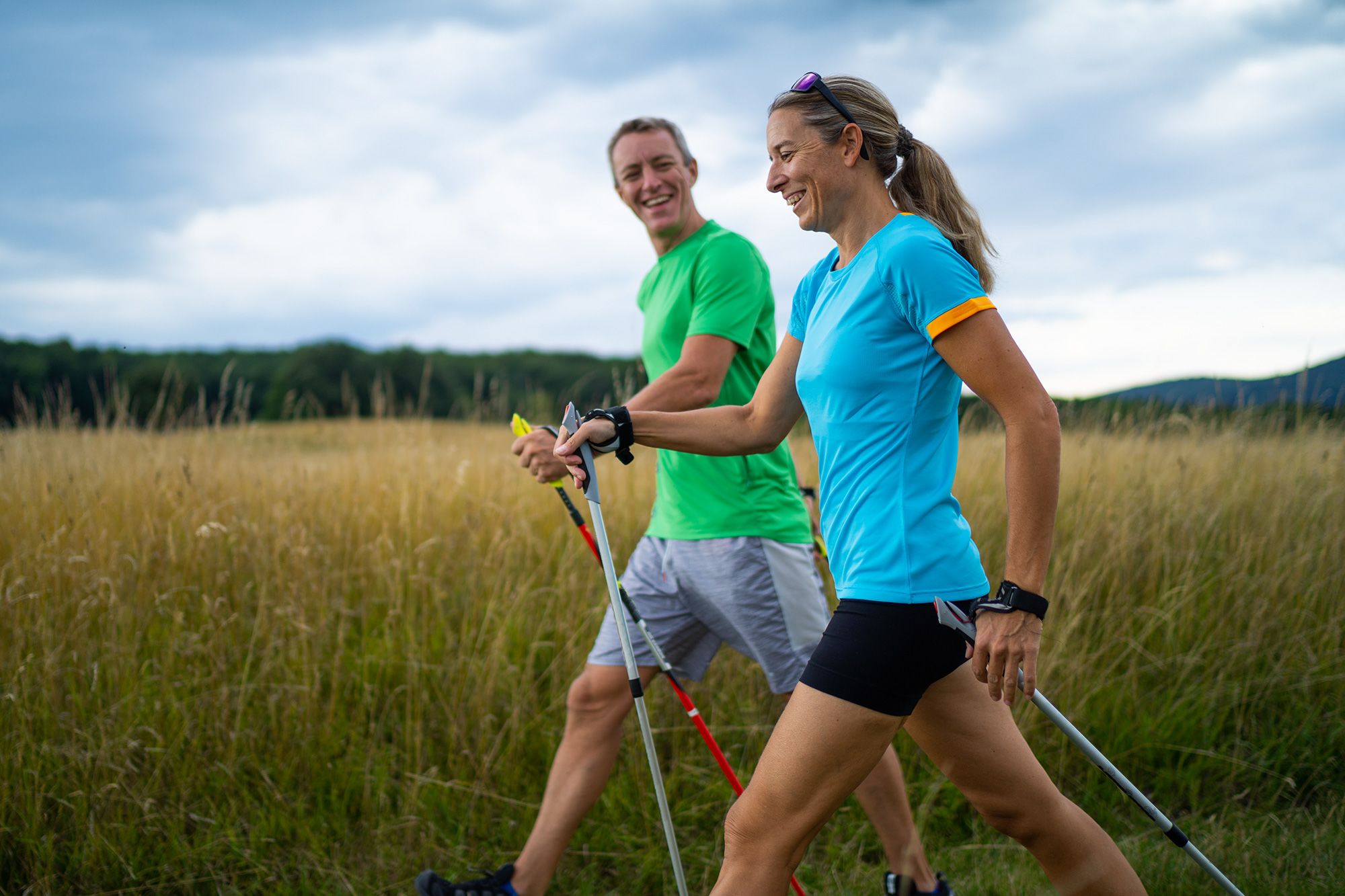Nordic walking isn’t just a ‘senior sport.’ It’s a fun way to burn calories and work your muscles

By Melanie Radzicki McManus, CNN
(CNN) — In Europe and other spots around the globe, it’s common to see people striding around the countryside with trekking poles in hand. Many folks even click their way through city centers with these poles — also known as walking sticks or hiking poles — because they provide support, enhance stability and take some of the load off your joints.
If you’re using Nordic walking poles, a specific type of trekking stick that requires a particular walking style, you can reap even more benefits.
For example, Nordic walking may reduce pain and fatigue in people with chronic conditions such as fibromyalgia, one study found.
This form of exercise also boosted functional capacity in patients with coronary artery disease better than high-intensity interval training or moderate-to-vigorous intensity continuous training, according to a 2022 randomized controlled trial. Functional capacity, a predictor of heart health, is your ability to perform daily tasks that require physical exertion, such as walking up stairs or carrying groceries.
Nordic walking burns roughly 20% more calories than regular strolls, too, according to the Cooper Institute in Dallas. Other estimates find the increased calorie burn can be as much as 67%. That’s because Nordic walking uses 80% to 90% of your muscles, as it engages both the upper and lower body, said Dr. Aaron Baggish, director of sports cardiology at Switzerland’s University of Lausanne.
Nordic walking is also just plain fun, said Ivan Semirechenskiy, vice president of the recently formed Nordic Walking Association of North America, who’s based in Alexandria, Virginia. Semirechenskiy, a former ballet soloist with the Bolshoi Theatre in Moscow, used Nordic walking as part of his recovery from a spinal issue. Today, he and Albert Fatikhov, president of the Nordic Walking Association of North America and a certified Nordic walking instructor, are introducing the sport to Americans to promote better health, performance and community.
“Some people think this is a senior sport, but it’s for everyone,” Semirechenskiy said. “It’s also a very social sport. You can create clubs and even teams.”
Indeed, there are Nordic walking organizations and competitions around the globe. Race distances vary, but several common ones are 5 kilometers (3.1 miles), 10 kilometers (6.2 miles) and 20 kilometers (12.4 miles). Fatikhov, incidentally, won multiple medals at the 2024 International Nordic Walking Federation World Championships.
It’s all in the poles
Nordic walking poles differ from traditional trekking poles because they have built-in gloves for your hands, not the simple loops found on hiking poles. The gloves wrap around the palm of your hand, allowing you to leverage the poles without gripping them.
“You’re transferring more energy to your arms and shoulders,” Baggish said.
Their tips are also slightly angled, as are the rubber caps you can purchase if you’re intending to use the poles on pavement versus earth. The angle is necessary because the pole tips hit the ground toward the middle of your foot or your heel, and you’re pushing backward with each step. When using hiking poles, in contrast, the poles hit the ground in front of your body and you’re pushing down.
“To get the most benefits from Nordic walking, you have to do it the right way,” Semirechenskiy said, interpreting for Fatikhov. “With hiking, you hold the pole all of the time. Here you push the pole backward, release it, shift it back up and hold it again.”
Baggish recommends Nordic walking to many of his patients, including elite athletes who often negotiate difficult terrain — for example, those who compete in mountain ultramarathons — as well as moderate exercisers who enjoy walking and hiking, and people with some type of disability for whom the use of Nordic walking poles enables them to move in a safer, healthier fashion.
Getting started is easy
It typically takes patients about five minutes to get the hang of moving with Nordic walking poles, Baggish said, and a few weeks for their use to become smooth and natural.
Most people just need a few lessons, Fatikhov agreed. “It depends how good you are at coordinating movements,” he said. “But don’t overthink it. This is not some special thing. This is natural walking.”
In Baggish’s practice, those with balance issues find using Nordic poles to be a game changer.
“Their favorite thing is walking uphill with the poles, as the perceived effort feels much less,” Baggish said. “That’s where the poles really have a benefit. They help uphill for force generation and downhill for stability.”
To get started, search for a class in your area or look for an online tutorial created by a certified Nordic walking instructor. It’s important to purchase true Nordic walking poles, too; Leki is widely considered one of the world’s most reliable brands, with Swix and Exel also ranking high. Poles generally cost anywhere from $80 to more than $150.
Baggish recommends initially trying Nordic walking for 10 minutes after consulting with your physician. Then, slowly increase the time until you’re comfortably walking with the poles for your entire exercise session. Ideally, such a session will be 30 minutes at a time, five days per week. Always stop immediately if you feel any pain.
If you normally use a cane to get around, no worries. Nordic walking is appropriate for you, too.
“Most people find they ultimately prefer the poles to a cane for any extended walking,” Baggish said, noting it’s best to have guidance first from a physical therapist and a short period of supervision.
In the end, it will be worth it.
“Nordic walking helps people recover from surgery, maintain their body shape, solve joint problems, maintain brain health and so on,” Semirechenskiy said. “It helps people be as healthy as they can be for life.”
The-CNN-Wire
™ & © 2025 Cable News Network, Inc., a Warner Bros. Discovery Company. All rights reserved.
